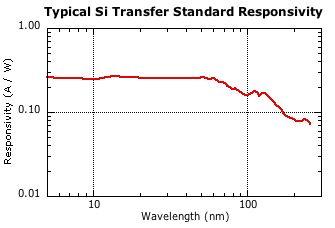Si EUV Photodiode Transfer Standard

Silicon (Si) photodiodes are issued by NIST as transfer standard detectors throughout the extreme ultraviolet spectral region (5 nm to 254 nm). Each device is an n-on-p junction with a thin (typically 5 nm) oxide layer grown on the front surface and specially processed to improve the radiation hardness. Once the chip is manufactured, it is mounted in a ceramic case. Redundant leads are wire bonded to the chip to make an electrical connection to two pins where user electronics may be easily attached. Incident radiation generates electron-hole pairs in the Si which cause an electric current to flow across the junction.
The responsivity of a Si photodiode is the externally detected electric current per unit of incident power. Typically, this is expressed in units of A / W. For wavelengths below about 60 nm, the responsivity is nearly independent of wavelength and has a value of about 0.28 A / W. The exact value depends on the transmission through the silicon dioxide layer and any internal losses (e.g. surface recombination) in the photodiode, both of which have some wavelength dependence and may vary considerable between different manufacturing lots. At longer wavelengths, the oxide transmission, charge injection from oxide absorption, and internal losses become much more significant. Additionally, the mean electron-hole pair creation energy is no longer constant with wavelength as the indirect bandgap absorption becomes significant. This manifests as a reduction on the responsivity at wavelengths longer than about 60 nm.
Si photodiodes have much higher responsivity than aluminum oxide photoemissive detectors, require no bias voltage, and are small and lightweight. However, they are noisier and exhibit higher dark currents than photoemissive standards and have broadband response from the infrared to the x-ray region.
Specifications/Capabilities
EUV Calibration Range: 5 nm to 254 nm
Useful Range: x-ray (5 keV to 10 keV) to infrared (1,100 nm)
Typical Responsivity: 0.07 A / W to 0.27 A / W
Dynamic Range: 10 pW to 10 mW (wavelength dependent)
Active Area: 10 mm by 10 mm
Scientific Opportunities/Applications
The Si transfer standard photodiodes are general-purpose radiometric detectors optimized for the extreme ultraviolet spectral region and are suitable for almost any application requiring the measurement of radiant power. Detector lots are selected for high radiation hardness and low-noise characteristics. These photodiodes are space-qualified and have significant flight heritage.

